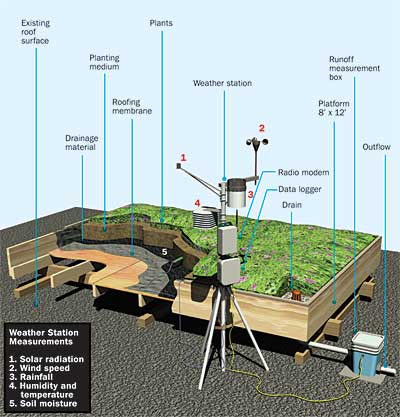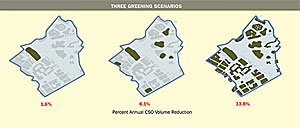Rooftops Slowly, but Steadily, Start to Sprout
Technology begins to take root on roofs in North America as new research supports claims of environmental benefits, and policies encouraging implementation multiply.
![]() Continuing Education
Continuing Education
Use the following learning objectives to focus your study while reading this month’s Continuing Education article.
Learning Objectives - After reading this article, you will be able to:
- Identify the benefits of planted rooftops.
- Describe the composition of planted rooftops.
- Explain why the number of structures with planted rooftops is increasing.
Planted material on top of buildings is hardly a new concept. From the fabled hanging gardens of Babylon to the vernacular sod-covered buildings of Scandinavia and the settlers of the American Great Plains to earth-sheltered architecture, vegetated roofs have many precedents.
Today, planted rooftops, while still far from common building practice in North America, are slowly gaining ground as a growing body of research supports the claim that green roofs are well suited for our climate. A properly installed green roof can reduce storm-water runoff, provide both heat and sound insulation, and create habitat for birds and insects. As part of a network of green roofs, it can mitigate urban heat-island effect. According to Green Roofs for Healthy Cities, a nonprofit industry association with the mission of promoting the technology, almost 2.5 million square feet of green roofs were planted in North America last year, a 72 percent increase from 2004.
Contemporary green roofs, also known as eco roofs, have their roots in German technology that is well developed after more than three decades of use. Although a number of systems are commercially available and a variety of combinations are possible, a green roof generally consists of planted material in a lightweight growing medium on top of a drainage and water-retention layer, a root barrier, and a waterproofing membrane.
Green roofs generally fall into two categories-either extensive or intensive. Extensive green roofs are lightweight, and may have as little as 3 or 4 inches of soil. They are usually planted with hardy, drought-resistant vegetation that requires little maintenance or irrigation.
With greater soil depth, intensive green roofs can support a wider variety of plant material, such as flowers, shrubs, or even small trees. These systems can be used to achieve a more landscaped, garden-like environment, but intensive green roofs may require maintenance such as watering, fertilization, or weeding. Designers also need to take into account the heavier roof loads that the deeper soil and more elaborate plantings will impose on the building's structural system.
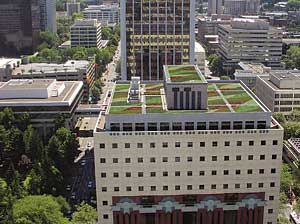 |
| Michael Graves's Portland Building will soon have a green roof as the result of a local resolution passed earlier this year. Officials will monitor how effectively the installation mitigates storm-water runoff. Rendering: Courtesy Macdonald Environmental Planning |
Sticks and carrots
Green roofs are taking hold most firmly in jurisdictions with policies and incentives that encourage implementation. "About 75 percent of the market is regulatory driven, but I see this as changing over time," says Sandra McCullough, business team leader for Green Grid, a supplier of a modular planted roof system.
In Chicago, building owners have planted more square feet of green roofs than those in any other North American city for two years in a row, according to Green Roofs for Healthy Cities. A total of 2.5 million square feet of green roofs are planned, in construction, or installed, says Michael Berkshire, the city's green projects administrator.
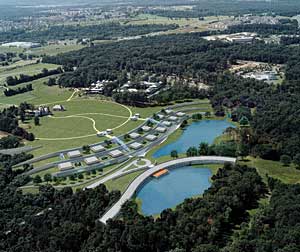 |
| Howard Hughes Medical
Institute Research Campus Slated to open in September, the Howard Hughes Medical Institute is building a research facility covered by a 180,000-square-foot green roof in Loudoun County, Virginia (left). Clusters of offices and conference rooms form the edges of curved and planted terraces. Support spaces not requiring natural light, such as the central plant and parking garage, are located away from the terrace edges. Rendering: © Rafael Viñoly Architects |
Not surprisingly, Chicago has an aggressive set of programs aimed at increasing implementation of green roofs and other sustainable building practices. Since planting of a 20,300-square-foot green roof on city hall in 2000, Chicago has instituted an incentive in the form of a density bonus for building owners that install green roofs. It also requires green roofs on construction projects that receive public assistance or are subject to review by the department of planning. Earlier this summer, the city council approved a plan to offer matching funds up to $100,000 toward the installation of green roofs on downtown buildings. "Our approach is a combination of the carrot and the stick," says Berkshire.
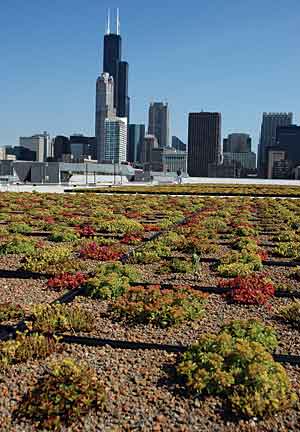 |
| South Loop Target Store Green Roof Installation Chicago has an aggressive set of policies to stimulate green roof development. The city requires green roofs on all buildings subject to review by its planning department. It also offers a density bonus and provides matching funds. So far, Chicago has about 2.5 million square feet of green roofs either planned, in construction, or completed. Green roofs have been planted on top of Chicago office towers, multifamily residential buildings, and stores, including the roof of a Target store in the city's South Loop. Photography: Courtesy Greengrid |
Green roof development is also relatively strong in several Washington, D.C.−area communities. Some sources attribute this demand for green roofs to the regional presence of the General Services Administration (GSA) and its commitment to sustainable building practices and certification of its facilities under the U.S. Green Building Council's LEED program. LEED recognizes green roofs as a storm-water rate- and quantity-management strategy. "Around Washington, D.C., the GSA is a large public landowner that is ‘walking the talk,' " says Steven Peck, Green Roofs for Healthy Cities president.
Local regulations directed at safeguarding the health of the Chesapeake Bay stemming from the federal Clean Water Act may also be responsible for the regional growth. In many of the municipalities comprising the bay's watershed, a green roof is considered an acceptable storm-water-management practice, says Pat Devlin, director of policy and protection at the Alliance for the Chesapeake Bay.
One recently occupied GSA project, the $61 million National Oceanic and Atmospheric Administration (NOAA)'s satellite operations center, in Suitland, Maryland, has the largest completed green roof on the Eastern Seaboard. Designed by Morphosis and Einhorn Yaffee Prescott, an approximately 70,000-square-foot, above-ground, conventionally roofed building houses the satellite control equipment. But the bulk of the facility-a 140,000-square-foot office space-is built into the side of a grassy slope. Courtyards and skylights provide natural light to the interior.
The primarily permeable surfaces of NOAA's site slow the rate and quantity of runoff and help remove undesirable solids and nutrients from this water, according to Max Kantzer, an associate at A. Morton Thomas & Associates, the project's civil engineer. The site needed only minimal storm-water-management features, such as a small detention structure, and shallow grass-lined swales. "The green roof reduces the amount of storm-water management needed on-site, and contributes a significant amount of water-quality control," he says.
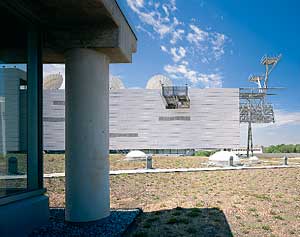 |
| National Oceanic and Atmospheric Administration At NOAA's new satellite operations center (below and bottom) in Suitland, Maryland, a conventionally roofed, 70,000-square-foot building houses the satellite control equipment. But the bulk of the facility- a 140,00-square-foot office space-is built into a grassy slope. The site's primarily permeable surfaces provide almost all of the required storm-water quantity and quality management. Photography: © Maxwell Mackenzie |
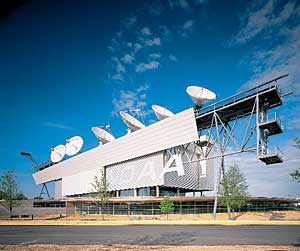 |
Another project under way in the region will have an even larger green roof. The Howard Hughes Medical Institute is building a research center in Loudoun County, Virginia, designed by Rafael Viñoly Architects (RVA). Clusters of offices and conference rooms are set into curved
terraces covered by a 180,000-square-foot green roof punctuated with interior courtyards. Support spaces not requiring natural light, such as a 300-car parking garage and a central plant, are also submerged under the green roof but are set away from the terraced edges.
| Click image for larger view |
| A Seattle research project is tracking both weather and runoff data at five green roof test plots (above). Rendering: Courtesy Magnusson Klemencic Associates |
The landscaped roof of the Howard Hughes facility will retain more storm water than a traditional lawn, and the runoff will not require extensive treatment to remove contaminants, due to its engineered drainage and planting media, says Jay Bargmann, AIA, RVA vice president. A built-up roof is considered to have a runoff coefficient of 0.95; in other words, about 95 percent of the water hitting a conventional roof will leave the surface and need to be accounted for in the design of the building's storm-water system. In comparison, a traditional lawn or turf area is considered to have a runoff coefficient of 0.35, while that of the Howard Hughes landscaped roof is 0.25. But Bargmann points to a less tangible benefit of the green roof as even more important. As he notes, "The project sets a standard for [preserving] open spaces in that suburban environment."
In the Pacific Northwest, a more modest size green roof is in the process of being installed on top of Michael Graves's Portland Building, completed in 1982. The 18,200-square-foot extensive installation, designed by Macdonald Environmental Planning, will include a variety of sedums and grasses, and was spawned by a city council resolution passed earlier this year. The regulation requires that new city buildings include a green roof, if practical, and also applies when roofs on existing buildings are replaced.
Â
The Portland Building roof will include a system to monitor how well the installation mitigates storm-water runoff. City officials hope to ultimately use the data collected, along with data from four other roofs it has been monitoring for several years, to fine tune requirements for various incentives aimed at increasing implementation of the technology. Results thus far show that the installations mitigate between 30 and 60 percent of total runoff, depending on factors such as the thickness and composition of the growing medium, and the type of plant material, according to Tom Liptan, the city's environmental specialist.
Portland offers a floor area ratio (FAR) bonus to building owners who incorporate green roofs into buildings in the center of the city. About 12 projects have taken advantage of the policy since it was instituted in 2001. "We are now starting to evaluate how we might improve the FAR bonus or develop policy to encourage green roof development in other areas of the city," says Liptan.
 |
The plots each employ a different green roof system. Performance under the same conditions varies (above). Data from one Seattle test plot (below) demonstrates that even after
successive storms, green roofs typically mitigate at least some runoff. |
 |
Green roof advocates say incentives are necessary to offset the expense. Even the most utilitarian extensive installation adds about $7 to $10 per square foot to the cost of a roof, estimates Drew Gangnes, director of civil engineering at Magnusson Klemencic Associates, a Seattle-based consulting firm.
Some jurisdictions allow a green roof as a substitute for other storm-water-management measures. However, even elimination of an underground retention tank will cover only 30 to 70 percent of the roof's cost, says Gangnes. "The public sector should provide incentives since there are public benefits," he says.
Gangnes's firm, along with a construction firm and several local developers, is monitoring the performance of five green roof test plots installed on top of four existing buildings around Seattle in February 2005. The 8-by-12-foot test plots each employ a different proprietary system, with a different thickness and composition of growing media and different plant material. So far, the data collected indicates that even in soggy Seattle, green roofs can be an effective storm-water-management strategy. The plots, even after successive storms, generally held water long enough for it to evaporate from the soil and transpire from the plants-a process called evapotranspiration.
Some researchers are developing predictive modeling tools to help building designers and owners calculate the retention and detention potential of a green roof with specific characteristics on an individual building. Earth Pledge, a new York City−based nonprofit environmental organization, is developing such a tool. The program will also have macro capabilities, allowing urban planners and government leaders to evaluate the aggregate impact of green roof development in a given sewer shed and direct resources. "It is a policy-making tool that will help identify the neighborhoods where green roofs will have the most significant impact," says Leslie Hoffman, executive director.
Toxic cocktail
A model of the type that Earth Pledge is developing could be particularly useful in cities with older, overtaxed combined sewer systems that transport both storm water and sewage. About half the time it rains in New York, for example, the volume of raw sewage and contaminated storm water exceeds the system's capacity. These occurrences, known as combined sewer overflows (CSOs), result in the release of this toxic mix directly into the city's surrounding waters.
Earth Pledge has so far built out the model with building-stock data, land-use characteristics, and infrastructure information for one sewer-shed subbasin in Lower Manhattan. The model predicts a 34 percent reduction in the volume of CSOs if all buildings in the study area were covered with green roofs. The reduction in the number of incidences of CSOs would be minimal due to the high percentage of impervious surfaces in the selected sewer shed, according to Earth Pledge. The group hopes to license the model to other cities, incorporating their rainfall and infrastructure data.
The storm-water model is part of a larger Earth Pledge green roof project. About a year ago, the group installed a 35,000-square-foot green roof on top of Silver Cup Studios in Long Island City, Queens, and is monitoring its thermal performance and storm-water-management capabilities. It will also monitor a 10,000-square-foot green roof that it is now installing on top of a warehouse in the same New York City neighborhood. Data from both sites will be used to test and refine the model.
| Click image for larger view |
| Penn State University Center for Green Roof Research A green roof can keep buildings cooler in summer (above) and can therefore help save on air- conditioning costs, according to studies conducted at PSU's Center for Green Roof Research (below). This strategy makes most sense in regions with long cooling seasons. Photography: © Pennsylvania State University |
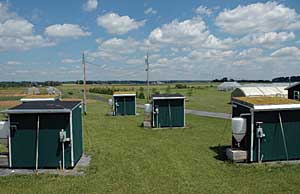 |
Storm-water issues are not the only area of current green roof investigation and modeling. One of several topics of study at the Pennsylvania State University (PSU) Center for Green Roof Research is the potential for green roofs' evaporative cooling to ameliorate the urban heat-island effect. PSU's facilities consist of six garden-shedlike wood-framed buildings that are heated and cooled. Three of these buildings have green roofs, while the other three have conventional roofs and serve as experiment controls, explains Robert D. Berghage, associate professor of horticulture. He tracks the temperatures on the test buildings' roofs and then determines the impact at the city scale through modeling.
Brad Bass, an adjunct professor at the Center for the Environment at the University of Toronto, has developed a modeling tool that can predict how much energy can be saved by including a green roof on an individual building. It takes into account such factors as local climate data, building configuration, and regional construction practices. Some researchers caution, however, that a green roof employed merely as an energy-saving device may not make economic sense to a building owner in a climate with a short cooling season.
PSU tests confirm that the insulative properties of green roofs reduce thermal loading and therefore can help save on air-conditioning costs. However, green roofs also prevent desirable heat during winter, says Berghage. But he points out that use of green roofs in climates with short cooling seasons could still have advantages. Widespread adoption of measures like green roofs that help cut energy use in the summer, the season associated with peak utility loads, could reduce the need for additions to the power-generation infrastructure. "Although this may not translate into a benefit for an individual owner, there is a societal benefit."

